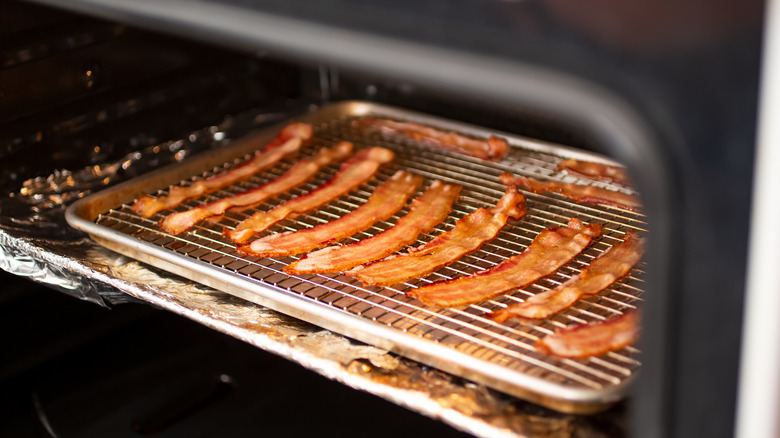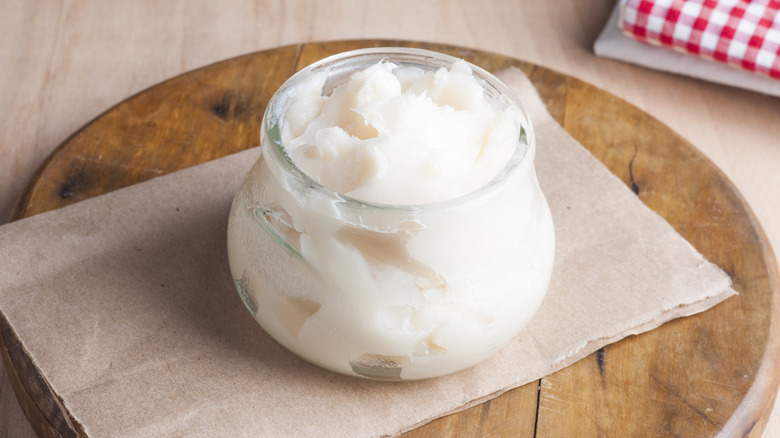The Easy Way Ina Garten Makes Her Breakfast Bacon
Learning how to make crispy breakfast bacon without burning it might be one of the toughest challenges for any beginner home cook. Overcrowding, choosing the wrong kind of slab pork, or even just using too hot a pan can make the difference between a savory or burnt strip of meat. Thankfully, there are a wide number of tips and suggestions that any home cook can follow to ensure their bacon comes out delicious. The biggest advice comes from professional chef Ina Garten, who utilizes the oven instead of the stovetop to cook these porky strips.
To roast bacon, the Barefoot Contessa preheats the oven to 400 degrees Fahrenheit and bakes it for about 15-20 minutes. This method allows you to cook a large quantity of food without needing to split it up into batches, making it the perfect method for feeding a crowd — or just eating a lot of bacon at once. Roasting the meat in the oven also allows you to multitask and prepare other breakfast items in the kitchen simultaneously.
If you choose to use the oven to cook your bacon, don't make the mistake of roasting it without parchment paper. The sheet will prevent any grease or burnt bits from sticking to the oven pan you're using, minimizing cleanup. Garten herself puts parchment paper down before layering on her bacon, so make your life (and cleanup) easier.
To roast better bacon in the oven, reach for the wire rack
While a sheet pan lined with some parchment paper should be enough to churn out some decent bacon in the oven, you're going to need a wire rack to take things to the next level. Doing so will let the hot convection air hit all sides of your food, making it crisp.
The wire rack also allows for any rendered fat to drip into the sheet pan, giving you less greasy bacon as a result. Ina Garten does recommend you exercise a bit of caution when you remove everything from the heat, as you don't want to touch or spill that boiling pool of grease on yourself.
This method does carry a bit of risk, as the bacon strips can stick to the wire rack and shatter if they're brittle enough. To stop your bacon from sticking, you'll want to nudge each piece as they are halfway done in the oven. You'll still have to open your oven's door and check on your bacon, but you won't have to take the time to flip every single strip if you want a crunchy exterior on both sides. Just one gentle shove should be enough to recoat the wire rack with rendered fat and keep things from lingering in one spot for too long.
Don't forgot to save the bacon drippings as well
Another benefit of Ina Garten's preferred method of roasting bacon in the oven is that any rendered fat will collect at the bottom of your baking tray. In the culinary world, this byproduct often gets compared to liquid gold for its ability to work as both a savory spread and cooking agent. The fact that bacon grease alone can work as a substitute for butter or oil should be enough incentive to make you try to save every drop in your pan, even if saving it will take a bit of effort on your end.
Once your rendered fat has cooled considerably, use a coffee filter or cheesecloth to filter out any burnt bacon pieces from the grease. This will ensure your stash lasts way longer in the fridge, as there won't be any remaining food particles that spoil faster. You can use a mesh sieve to achieve similar results, but be aware that using this over a coffee filter or cheesecloth will not prevent any minuscule burnt pieces from going through. Once you've purified your bacon fat, it can be moved into an airtight container and put away in the fridge for up to three months.



